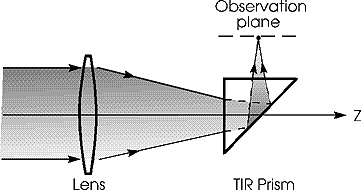
![]()
Optical System
Simulation Software
 |
|
|
The Goos-H�nchen Effect Total internal reflection from the rear facet of a prism causes a small (but measurable) displacement of a beam. A comprehensive analysis of this phenomenon, which is known as the Goos-H�nchen Effect, involves decomposition of the incident beam into its plane-wave spectrum, computation of the Fresnel reflection coefficients for each such plane-wave, and superposition of the reflected plane-waves. DIFFRACT performs all these tasks routinely and automatically. In the system shown below, where the lens has a numerical aperture of 0.05 and the refractive index of the glass prism is 1.5, the focused spot will be displaced along the positive Z-axis by about 1.5 waves.

  
Logarithmic plots of intensity distribution at the focal plane of the lens, including the effects of total internal reflection at the rear facet of the prism. The three frames represent the focused spot's components of polarization along the X-, Y-, and Z-axes, although the majority of the optical power (more than 99%) is contained in the middle frame. The diameter of the Airy disk (central bright spot in the middle frame) is approximately 25 waves. The Goos-H�nchen effect is manifested in the 1.5 waves downward shift of the distributions.
Home
| About MM Research, Inc. | Online
Publications © Copyright 1987-2011, MM Research, Inc. 5748 N. Camino del Conde, Tucson, Arizona 85718 |